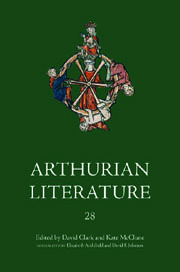Book contents
- Frontmatter
- Contents
- General Editors' Foreward
- Preface
- List of Contributors
- Abbreviations
- I Reading Malory's Bloody Bedrooms
- II (Dis)Figuring Transgressive Desire: Blood, Sex, and Stained Sheets in Malory's Morte Darthur
- III Bewmaynes: the threat from the kitchen
- IV Sibling Relations in Malory's Morte Darthur
- V ‘Traytoures’ and ‘Treson’: the Language of Treason in the Works of Sir Thomas Malory
- VI ‘The Vengeaunce of My Brethirne’: Blood Ties in Malory's Morte Darthur
- VII Malory and the Scots
- VIII Blood, Faith and Saracens in ‘The Book of Sir Tristram’
- IX Barriers Unbroken: Sir Palomydes the Saracen in ‘The Book of Sir Tristram’
- X Virginity, Sexuality, Repression and Return in the ‘Tale of the Sankgreal’
- XI Launcelot in Compromising Positions: Fabliau in Malory's ‘Tale of Sir Launcelot du Lake’
- Title in the Series
VIII - Blood, Faith and Saracens in ‘The Book of Sir Tristram’
Published online by Cambridge University Press: 05 February 2013
- Frontmatter
- Contents
- General Editors' Foreward
- Preface
- List of Contributors
- Abbreviations
- I Reading Malory's Bloody Bedrooms
- II (Dis)Figuring Transgressive Desire: Blood, Sex, and Stained Sheets in Malory's Morte Darthur
- III Bewmaynes: the threat from the kitchen
- IV Sibling Relations in Malory's Morte Darthur
- V ‘Traytoures’ and ‘Treson’: the Language of Treason in the Works of Sir Thomas Malory
- VI ‘The Vengeaunce of My Brethirne’: Blood Ties in Malory's Morte Darthur
- VII Malory and the Scots
- VIII Blood, Faith and Saracens in ‘The Book of Sir Tristram’
- IX Barriers Unbroken: Sir Palomydes the Saracen in ‘The Book of Sir Tristram’
- X Virginity, Sexuality, Repression and Return in the ‘Tale of the Sankgreal’
- XI Launcelot in Compromising Positions: Fabliau in Malory's ‘Tale of Sir Launcelot du Lake’
- Title in the Series
Summary
Sir Palomydes is a remarkable figure, both for the richness of his interior life and because he, an unbaptized Saracen, operates within the Christian context of the Arthurian fellowship. In earlier English romances, and to some extent in the main French source for Malory's ‘Book of Sir Tristram’, Saracen men are flat figures with specific roles (the bestial giant, the ruthless sultan, the powerful enemy knight); they have in common ‘a reckless, deviant disposition and violent will to power’. In Le Morte Darthur Sir Palomydes departs from these earlier imaginings of Saracens, particularly in his relationship to power and violence, and in the disjunction between his public and private selves. Despite this movement away from the familiar model of a Saracen toward a more nuanced portrayal, Palomydes does not entirely flout generic expectations: despite his conversion he will never become fully integrated into Arthurian society. Palomydes' unshakeable otherness is not delineated by particular habits, practices or physical attributes, but by two narrative limits on his accomplishments and integration. First, the narrative structure avoids engaging with the idea of a fully converted knight living within Christian society by dropping Palomydes from the narrative after his baptism. Second, Palomydes' failure to win Isode, like the cuckolding of his brother Sir Segwarydes, is in keeping with an English romance tradition of sexually emasculated Saracen men. These narrative choices suggest a tension between Palomydes' blood (in the sense of his origins) and his faith.
- Type
- Chapter
- Information
- Arthurian Literature XXVIIIBlood, Sex, Malory: Essays on the 'Morte Darthur', pp. 121 - 136Publisher: Boydell & BrewerPrint publication year: 2011



